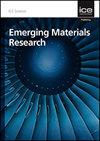Image-driven deep learning enabled automatic microstructural recognition
IF 1.2
4区 材料科学
Q4 MATERIALS SCIENCE, MULTIDISCIPLINARY
引用次数: 1
Abstract
Deep learning (DL) method consisting of Convolutional Neural Network (CNN) was employed to automate the task of microstructural recognition and classification to identify dendritic characteristics in metallic microstructures. The dendrites are an important feature which decide the mechanical properties of an alloy, further the dendritic arm spacing is critical in ascertaining the values of strength and ductility. The current work has been divided into two tasks i.e., classification of microstructures into dendritic and non-dendritic (Task 1) and further classifying the dendritic microstructures into longitudinal and cross-sectional view (Task 2). The data set comprising of micrographs from experimental and online sources covering a broad range of alloy compositions, micrograph magnifications and orientations. The tasks were achieved by employing a 4 layered CNN to yield an accuracy of 97.17±0.64% for Task 1 and 87.86±1.07% for Task 2 independently. The employment of deep learning model for classification of microstructures circumvents the feature extraction step while ensuring high accuracy. This work reduces dependency on skilled and experienced researchers and expedites the material development cycle.图像驱动的深度学习实现了自动微结构识别
采用卷积神经网络(CNN)组成的深度学习(DL)方法,实现了微结构识别与分类的自动化,以识别金属微结构中的枝晶特征。枝晶是决定合金力学性能的重要特征,枝晶臂间距是确定合金强度和塑性的关键因素。目前的工作分为两个任务,即将微观结构分为枝晶和非枝晶(任务1),并进一步将枝晶微观结构分为纵向和横向视图(任务2)。数据集包括来自实验和在线来源的显微照片,涵盖了广泛的合金成分,显微照片放大和方向。通过采用4层CNN来完成任务,任务1的准确率为97.17±0.64%,任务2的准确率为87.86±1.07%。采用深度学习模型对微结构进行分类,在保证高精度的同时避免了特征提取步骤。这项工作减少了对熟练和经验丰富的研究人员的依赖,并加快了材料开发周期。
本文章由计算机程序翻译,如有差异,请以英文原文为准。
求助全文
约1分钟内获得全文
求助全文
来源期刊

Emerging Materials Research
MATERIALS SCIENCE, MULTIDISCIPLINARY-
CiteScore
4.50
自引率
9.10%
发文量
62
期刊介绍:
Materials Research is constantly evolving and correlations between process, structure, properties and performance which are application specific require expert understanding at the macro-, micro- and nano-scale. The ability to intelligently manipulate material properties and tailor them for desired applications is of constant interest and challenge within universities, national labs and industry.
 求助内容:
求助内容: 应助结果提醒方式:
应助结果提醒方式:


